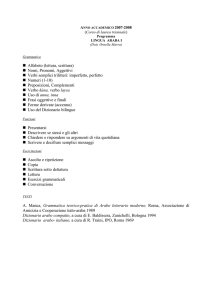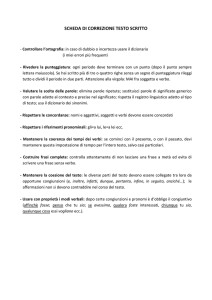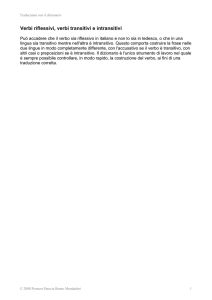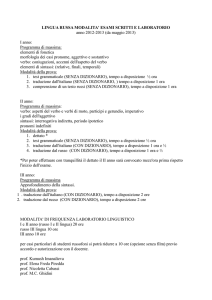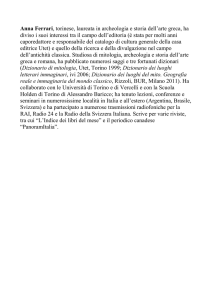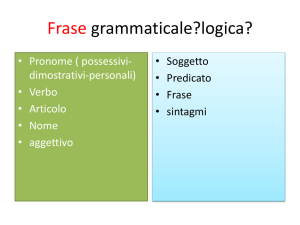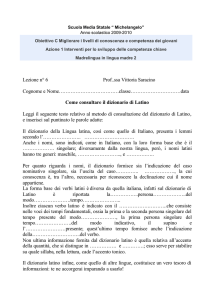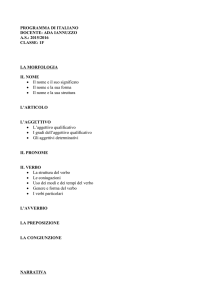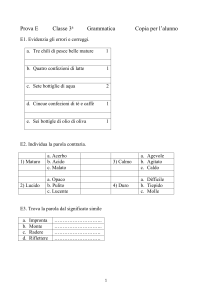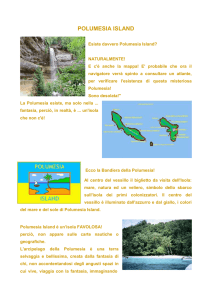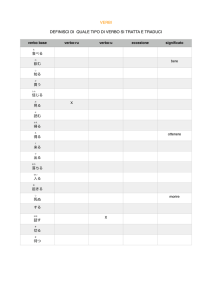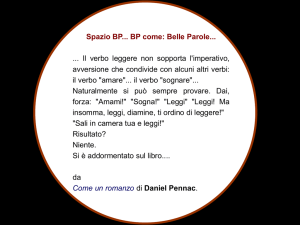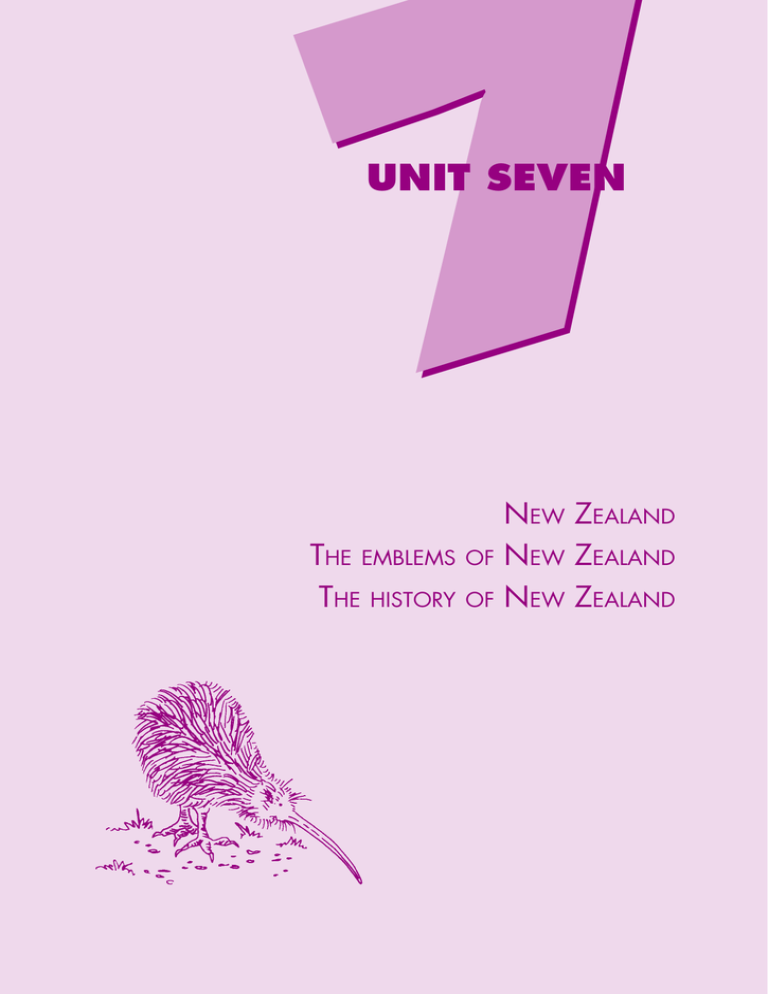
7
7
UNIT SEVEN – NEW ZEALAND
UNIT SEVEN
THE EMBLEMS
THE HISTORY
271
OF
OF
NEW ZEALAND
NEW ZEALAND
NEW ZEALAND
S
SIMPLE ENGLISH CULTURE
New Zealand
Trova la Nuova Zelanda nella carta del mondo e colorala.
New Zealand is a country in the southern hemisphere. It lies south-east of Australia between
the South Pacific Ocean in the east and Tasman Sea in the west. It consists of two islands, the
North Island and the South Island, which are separated by the Cook Strait, and a number
of smaller islands.
Completa la cartina scrivendo al posto esatto i nomi dentro il riquadro.
Australia
North Island
South Island
South Pacific Ocean
Tasman Sea
272
7
UNIT SEVEN – NEW ZEALAND
Traduci le parole tra parentesi.
La Nuova Zelanda è un
(country) nell’emisfero sud. Si trova a sud-est
dell’Australia fra l’Oceano Pacifico del Sud a est e il Mare di Tasman a ovest. Consiste di
due
(islands), l’Isola del Nord e l’Isola del
(South), che sono
separate dallo Stretto di Cook, e di altre isole più piccole.
_____________________________________________
_____________________________________________
___________________________________
Unisci le parole inglesi alla loro traduzione italiana.
Hemisphere
sud
Country
nord
North
emisfero
South
più piccole
Smaller
isole
Islands
Paese
The North Island is green, hilly and volcanic. It has beautiful beaches and a rainforest. The
South Island is more mountainous than the North. It has fiords, lakes and glaciers. The highest
peak is Mt. Cook (3,764 meters), after the name of Captain James Cook who explored New
Zealand in the 18th century.
Traduci le parole tra parentesi.
L’Isola del Nord è verde, collinare e
(volcanic). Ha belle spiagge e una foresta
pluviale. L’Isola del Sud è più montagnosa dell’Isola del Nord. Ha fiordi,
(lakes) e ghiacciai. Il picco più alto
(is) il monte Cook (3.764 metri), dal capitano
James Cook che ha esplorato la Nuova Zelanda nel 18°
(century).
_____________________________________________
_____________________________________________
_________________
_____________________________________________
Unisci le parole inglesi alla loro traduzione italiana.
Hilly
picco
Beaches
ghiacciai
Volcanic
laghi
Glaciers
montagnoso
Lakes
vulcanico
Peak
spiagge
Rainforest
collinare
Mountainous
foresta pluviale
273
S
SIMPLE ENGLISH CULTURE
New Zealand has a population of 4
million people. Wellington, the capital,
is located at the bottom of the North
Island, but Auckland is the largest city.
Like Sydney, Auckland has a spectacular
harbour and bridge. In the South
Island the most important cities are
Christchurch and Queenstown.
Auckland
NORTH ISLAND
SOUTH ISLAND
Wellington
M
k
oo
C
t.
Christchurch
Queenstown
STEWART ISLAND
Completa con i dati delle due isole.
Cities
North Island
A
Physical features
H
_____ _____ _____ _____ _____ _____
W
_____ _____ _____ _____ _____ _____ _____ _____ _____
G
V
South Island
C
Q
_____ _____ _____ _____ _____ _____ _____ _____ _____ _____ _____
_____ _____ _____ _____
_____ _____ _____ _____
_____ _____ _____ _____ _____ _____ _____
M
_____ _____ _____ _____ _____ _____ _____ _____ _____ _____
_____ _____ _____ _____ _____ _____ _____ _____
Traduci le parole tra parentesi.
La
(New Zealand) ha una popolazione di 4 milioni di
(people).Wellington, la
(capital), è in fondo all’Isola del Nord, ma Auckland
è la città
(largest). Come Sydney, Auckland ha uno spettacolare porto e
ponte. Nell’Isola del Sud le città più
(important) sono Christchurch e
Queenstown.
____________________________________________________________
__________________________________________
__________________________________________
______________________________________________
________________________________________________
274
7
UNIT SEVEN – NEW ZEALAND
Colora dello stesso colore le citta e l’isola in cui si trovano.
North Island
South Island
Queenstown
Wellington
Christchurch
Auckland
True or false: scrivi accanto alle frasi se sono vere o false.
True (vero)
False (falso)
1. New Zealand is in the southern hemisphere.
2. There are four major islands.
3. Between the North Island and the South Island
there is Cook Strait.
4. Cook was a famous explorer.
5. The North Island has high mountains.
6. Mt. Cook is in the North Island.
7. The rainforest is in the North Island.
8. Auckland is in the South Island.
9. The capital is Wellington.
10. Christchurch is an important city.
Completa il brano con le parole del riquadro.
hilly
southern
Christchurch
population
Island
beaches
capital
peak
glaciers
city
New Zealand is a country in the
hemisphere. It consists of two islands, the
North Island and the South
. The North Island is green,
and volcanic. It has beautiful
and a rainforest. The South Island has fiords,
lakes and
. The highest
is Mt. Cook (3,764 meters).
New Zealand has a
of 4 million people. Wellington is the
but Auckland is the largest
. In the South Island the most important cities are
and Queenstown.
__________________________________________
________________________________________
________________________________________
________________________________________
___________________________________
___________________________________
_____________________________________
_____________________________________
_____________________________________
_____________________________________
275
S
SIMPLE ENGLISH CULTURE
The emblems of New Zealand
The flag
The New Zealand flag has a royal blue background, the Union Jack in the first quarter and four
five-pointed red stars of the Southern Cross on the right. The stars have white borders.
Colour the flag of New Zealand blue, white and red.
The kiwi
The kiwi is the national emblem of New
Zealand. The kiwi is a bird but it cannot
fly. It is brown with a long, sharp bill. It
lives in forests and grasslands. The kiwi
eats insects, worms and spiders but also
seeds and fruit. The kiwi has given its
name to New Zealanders, who are called
«Kiwis» the world over.
276
7
UNIT SEVEN – NEW ZEALAND
Traduci le parole tra parentesi.
Il kiwi è il simbolo
(national) della Nuova Zealanda. Il kiwi è un uccello
ma non può
(fly). È marrone con un
(long) becco appuntito.
Vive nelle
(forests) o nelle praterie. Il kiwi mangia
(insects),
vermi e ragni ma anche semi e
(fruit). Il kiwi ha dato il suo
(name) ai Neozelandesi, che sono chiamati «Kiwis» in tutto il
(world).
_______________________________________________
__________________________________________
__________________________________________
__________________________________________
__________________________________________
__________________________________________
__________________________________________
__________________________________________
The silver fern
There are about 190 species of native ferns found
in New Zealand. The silver fern is New Zealand
emblem and is a symbol that is used on the shirts
of the All Blacks rugby team and also the Silver
Ferns netball team.
Traduci le parole tra parentesi.
Ci sono circa 190
(species) di felci native che si trovano in
(New Zealand). La felce argentata è l’emblema della Nuova Zealanda ed è il
(symbol) usato sulle
(shirts) della squadra di rugby All Blacks e anche della
(team) di netball Silver Fern.
_________________________________
_________________________________________________________
__________________________________________
__________________________________________
__________________________________________
Unisci le parole inglesi alla loro traduzione italiana.
Background
Fern
Bird
Bill
Sharp
Worms
Seeds
Team
Fly
Spiders
appuntito
uccello
volare
vermi
felce
ragni
sfondo
becco
squadra
semi
277
S
SIMPLE ENGLISH CULTURE
Trova le 20 parole (12 orizzontali e 8 verticali) che si riferiscono alla Nuova
Zelanda e scrivile sotto.
T
A
L
L
B
L
A
C
K
S
F
E
R
T
A
S
M
A
N
I
G
L
A
S
O
U
T
H
E
O
W
R
A
M
T
V
C
B
I
L
L
I
E
G
C
O
O
K
D
E
M
B
L
E
M
W
E
L
L
I
N
G
T
O
N
I
O
H
C
A
B
E
A
C
H
E
S
R
Y
A
N
O
R
T
H
O
P
L
M
A
N
D
R
U
G
B
Y
C
A
S
S
I
L
V
E
R
F
E
R
N
B
L
C
N
A
T
I
V
E
B
D
ORIZZONTALI
VERTICALI
A
A
_____ _____
B
T
I
V
_____ _____ _____ _____
F
_____ _____ _____
_____ _____ _____ _____
_____ _____ _____ _____ _____
W
_____ _____ _____
_____ _____ _____
_____ _____ _____ _____ _____ _____ _____
W
_____ _____ _____ _____
_____ _____ _____ _____ _____
_____ _____ _____ _____
_____ _____ _____ _____ _____
T
_____ _____ _____ _____ _____
N
_____ _____ _____
K
_____ _____ _____ _____ _____
N
_____ _____ _____ _____ _____ _____ _____
G
_____ _____ _____
E
S
F
_____ _____ _____
C
S
_____ _____ _____ _____ _____
_____ _____ _____ _____ _____ _____
B
R
B
_____ _____ _____ _____ _____ _____ _____ _____ _____
278
_____ _____ _____ _____
7
UNIT SEVEN – NEW ZEALAND
The history of New Zealand
The Polynesian Maori arrived in New Zealand in about A.D.
Cloud = nuvola
800. The land was called Aotearoa, meaning «land of the long
Reached = raggiunse
white cloud».
Prevented = impedirono
In 1642 Abel Janszoon Tasman was the first European explorer
Landing = sbarcare
who reached New Zealand, but the natives Maori prevented him
Whalers = balenieri
from landing. In 1769 Captain James Cook, a British explorer,
circumnavigated the two main islands aboard the Endeavour.
Traders = commercianti
From the late 1790s on, whalers, traders and missionaries arrived,
Treaty = trattato
establishing settlements along the coast.
Defeat = sconfitta
The Maori, indigenous people of New Zealand, signed a treaty
Granted = concesse
with the British on 6th February 1840, known as the Treaty of
Running = gestione
Waitangi. The Maori ceded sovereignty of their country to Britain
in exchange for protection and guaranteed possession of their
lands. In that same year, the British began the first organized colonial settlement. A series of
land wars between 1843 and 1872 ended with the defeat of the native peoples.
In 1893 New Zealand was the first country in the world that granted women the right to vote.
The British colony of New Zealand became a dominion in 1907, and totally independent
in 1947. New Zealand is now an independent country but it is part of the Commonwealth
of Nations. The British monarch is the Head of the State, but he/she plays no active role in
the running of New Zealand’s government.
Traduci le parole tra parentesi.
I Maori polinesiani
(reached) la Nuova Zelanda nell’800 d.C. La terra fu
chiamata Aotearoa, che significa «terra della lunga
(cloud) bianca».
Nel 1642 Abel Janszoon Tasman fu il primo
(explorer) europeo che raggiunse
la Nuova Zelanda, ma i nativi Maori gli impedirono di sbarcare. Nel 1769 il
(Captain) James Cook, un esploratore britannico, circumnavigò le due isole principali a
bordo dell’Endeavour. Dalla fine degli anni 1790,
(whalers), commercianti
e missionari arrivarono, stabilendo degli
(settlements) lungo la costa.
I Maori, i nativi della Nuova Zelanda, firmarono un trattato con i britannici il 6
(February) 1840, conosciuto come il Trattato di Waitangi. I Maori cedevano la sovranità del
loro
(country) alla Gran Bretagna in cambio della
(protection)
e del garantito possesso delle loro terre. Nello stesso
(year), i britannici iniziarono
il loro primo insediamento coloniale organizzato. Una serie di guerre di terra fra il 1843 e il
1872 finì con la
(defeat) dei popoli nativi.
__________________________________________
__________________________________________
__________________________________________
___________________________________
__________________________________________
__________________________________________
__________________________________
_________________________________
_________________________________________
____________________________
__________________________________________
279
S
SIMPLE ENGLISH CULTURE
Nel 1893 la Nuova Zelanda fu il
(first) Paese al mondo a concedere il diritto
di voto alle donne. La colonia britannica della Nuova Zelanda
(became) un
dominion nel 1907, e completamente indipendente nel 1947. La Nuova Zelanda è ora un
paese
(independent) ma fa parte del Commonwealth Britannico. Il monarca
britannico è il
(Head of State), ma non riveste alcun ruolo attivo nella
gestione del
(government) neozelandese.
_________________________________
_____________________________________
______________________________________________
___________________________________________________
__________________________________________
Abbina le parole inglesi alla loro traduzione italiana.
Cloud
nativi
Natives
sovranità
Landing
terre
Settlements
diritto
Sovereignty
nuvola
Signed
sconfitta
Lands
sbarcare
Defeat
insediamenti
Right
firmarono
True or false: scrivi accanto alle frasi se sono vere o false.
True (vero)
1. The Maori came from Polynesia.
2. The Maori are the indigenous people of
New Zealand.
3. Aotearoa means «land of the short white cloud».
4. Tasman reached New Zealand in 1645.
5. Captain James Cook was a Maori explorer.
6. Settlements were established along the coast
since 1790s.
7. The land wars ended in 1842 with the defeat
of the Maori.
8. In 1893 women were granted the right to vote.
9. New Zealand is totally independent since 1907.
10. New Zealand is part of the Commonwealth.
280
False (falso)
7
UNIT SEVEN – NEW ZEALAND
Nel brano i verbi al passato sono scritti in corsivo. Ci sono due verbi irregolari,
oltre al verbo essere. Gli altri sono tutti regolari (terminano per -ed). Scrivili tutti
nello schema.
Verbo essere
Verbi regolari
Verbi irregolari
___________________________________________________________________
___________________________________________________________________
___________________________________________________________________
___________________________________________________________________
___________________________________________________________________
___________________________________________________________________
___________________________________________________________________
___________________________________________________________________
___________________________________________________________________
___________________________________________________________________
___________________________________________________________________
___________________________________________________________________
___________________________________________________________________
___________________________________________________________________
___________________________________________________________________
___________________________________________________________________
___________________________________________________________________
___________________________________________________________________
___________________________________________________________________
___________________________________________________________________
___________________________________________________________________
___________________________________________________________________
___________________________________________________________________
___________________________________________________________________
___________________________________________________________________
___________________________________________________________________
___________________________________________________________________
___________________________________________________________________
___________________________________________________________________
___________________________________________________________________
Was
Rispondi alle domande.
1. When did the Polynesian Maori arrive in New Zealand?
2. What does Aotearoa mean?
__________________________________________________________________________________________________________________________________________________
3. When did Tasman reach New Zealand?
4. Who prevented him from landing?
5. Who was James Cook?
____________________________________________________________________________________________________________________
_______________________________________________________________________________________________________________________________
_____________________________________________________________________________________________________________________________________________________________
6. What was the name of his ship?
_______________________________________________________________________________________________________________________________________
7. Who arrived from the late 1790s?
__________________________________________________________________________________________________________________________________
8. What was established with the Treaty of Waitangi?
9. When was it signed?
__________________________________________________________________________
_________________________________________________________________________________________
____________________________________________________________________________________________________________________________________________________________________
10. What happened from 1843 to 1872?
11. Who won the land wars?
12. What happened in 1893?
__________________________________________________________________________________________________________________________
________________________________________________________________________________________________________________________________________________________
______________________________________________________________________________________________________________________________________________________
13. When did New Zealand become independent?
14. Who is the Head of State?
_________________________________________________________________________________________________
_____________________________________________________________________________________________________________________________________________________
15. Does the Head of State have an important role?
281
_______________________________________________________________________________________________
S
SIMPLE ENGLISH CULTURE
Quiz about New Zealand: rispondi alle domande.
1. New Zealand is
in the southern hemisphere
in Europe
in the northern hemisphere
9. The silver fern is
on the national flag
on the All Blacks’ shirts
an animal
2. It consists of
two islands
three islands
many islands
10. The Maori
are the original inhabitants of
New Zealand
live in Australia
arrived from Europe
3. The North Island is
green, hilly and with many glaciers
hilly, mountainous with many fiords
green, hilly and volcanic
11. Aotearoa means
land of the short white cloud
land of the long white cloud
land of the long black cloud
4. The South Island
is green, hilly and with many
beautiful beaches
is mountainous with many fiords
has a rainforest
12. James Cook arrived in New Zealand
in 800 A.D.
in 1642
in 1769
5. New Zealand’s capital is
Wellington
Auckland
Christchurch
13. The Endeavour was
a Maori king
James Cook’s ship
a whaler
6. Queenstown is
in the North Island
in the South Island
the capital of New Zealand
14. In 1893
women could vote
Maori could vote
British could vote
7. The national flag has
the Union Jack in the first quarter
the Union Jack in the second quarter
no Union Jack
15. In 1947
the Treaty of Waitangi was signed
New Zealand became a dominion
New Zealand became totally
independent
8. The kiwi is a
flag
plant
bird
16.The Head of State is
the British monarch
the American President
a Maori
282
D
D
UTILIZZARE IL DIZIONARIO
UTILIZZARE IL DIZIONARIO
283
S
SIMPLE ENGLISH CULTURE
Utilizzare il dizionario
Quando non sai il significato di una parola inglese e il contesto, la somiglianza con l’italiano, la
conoscenza dell’argomento non ti aiutano, devi usare il dizionario. Un dizionario può essere:
– monolingua, cioè scritto tutto in una sola lingua (dizionario italiano, dizionario inglese,
ecc.);
– bilingua, cioè che contiene due lingue; nel caso del dizionario bilingua italiano e inglese
trovi nella prima parte le parole inglesi con la traduzione in italiano, e nella seconda parte
le parole italiane con la traduzione inglese.
Quando cerchi la traduzione di una parola inglese devi fare attenzione perché esistono più
lettere nell’alfabeto inglese che in quello italiano.
A B C D E F G H I J K L M N O P Q R S T U V W X Y Z
Quali sono le lettere che non sono presenti nell’alfabeto italiano? Evidenziale.
J
B
T
L
Y
I
C
R
K
Q
Z
V
P
M
O
A
D
F
W
N
X
E
G
H
S
U
Q
Scrivi le consonanti mancanti.
B
D
T
F
M
P
V
X
H
J
Q
R
Z
Completa con le lettere mancanti.
A
B
Q
K
R
S
L
T
D
E
F
T
U
V
J
G
I
X
Z
N
C
E
U
G
I
284
J
G
J
D
UTILIZZARE IL DIZIONARIO
Scrivi quale lettera nell’alfabeto precede quella indicata.
___________
C
___________
I
___________
L
Q
___________
Z
___________
___________
X
___________
K
___________
O
___________
Y
Scrivi quale lettera nell’alfabeto segue quella indicata.
H
__________
J
__________
V
__________
X
I
__________
R
__________
__________
K
__________
W
_________
Y
__________
B
__________
Metti le vocali in ordine alfabetico.
Scrivi la lettera che segue l’ultima della serie.
A
B
C
F
G
H
U
V
W
H
I
J
T
U
V
Scegli fra quelle a fianco quale lettera completa la serie, come nell’esempio.
Esempio: nella serie
A
C
C
fra queste lettere
D
G
B
la risposta giusta è la G perché: A (B) C (D) E (F) G quindi ho sempre saltato una lettera.
Ora prova tu!
D
F
H
J
I
L
Q
S
U
T
V
W
T
V
X
W
Z
Y
E
G
I
K
J
L
285
S
SIMPLE ENGLISH CULTURE
Per mettere le parole in ordine alfabetico bisogna guardare alla prima lettera di ogni
parola. Fra una parola che inizia con la a e una che inizia con la b, per esempio,
verrà prima la parola che inizia con la a perché viene prima nell’alfabeto.
Metti questi animali in ordine alfabetico.
giraffe
1.
_________________________________
elephant
2.
_________________________________
zebra
3.
lion
_________________________________
4.
_________________________________
monkey
5.
_________________________________
Metti questi colori in ordine alfabetico.
yellow
1.
_________________________________
blue
2.
_________________________________
red
3.
pink
_________________________________
4.
_________________________________
white
5.
_________________________________
Se la prima lettera è la stessa, si guarda alla seconda lettera di ogni parola.
Metti queste parole in ordine alfabetico.
garage
1.
go
2.
glad
3.
geography
4.
grandma
5.
guide
6.
girl
7.
_________________________________
_________________________________
_________________________________
_________________________________
Se anche la seconda lettera è la
stessa, dobbiamo guardare alla
terza lettera, e così via. Ad esempio, nelle parole blue e black, la
prima lettera (b) è la stessa, e
anche la seconda (l). La terza
lettera invece è diversa (u – a).
Fra la a e la u, la lettera che viene
prima nell’alfabeto è la a, quindi
l’ordine giusto è: black; blue.
_________________________________
_________________________________
_________________________________
286
D
UTILIZZARE IL DIZIONARIO
Metti queste parole in ordine alfabetico.
Crew
1.
crawl
2.
cruel
3.
cross
4.
cruise
5.
crocodile
6.
crab
7.
_________________________________
_________________________________
_________________________________
_________________________________
_________________________________
_________________________________
_________________________________
Metti queste parole in ordine alfabetico.
cat
milk
kangaroo
house
hello
jogging
water
1.
5.
9.
_____________________________________________
_____________________________________________
_____________________________________________
13.
Internet
__________________________________________
cake
yoghurt
morning
2.
6.
_____________________________________________
14.
friend
jeep
door
_____________________________________________
10.
dog
__________________________________________
__________________________________________
3.
7.
_____________________________________________
_____________________________________________
11.
15.
287
__________________________________________
__________________________________________
zoom
4.
8.
_____________________________________________
_____________________________________________
12.
16.
__________________________________________
__________________________________________
S
SIMPLE ENGLISH CULTURE
In alto nel dizionario si trovano le «guide words», parole che corrispondono alla prima e
all’ultima della singola pagina o delle due pagine. Nel dizionario cerca le seguenti parole e
scrivi le due «guide words» (parole guida) che trovi.
Parole in inglese
Significato
Prima parola guida
Seconda parola guida
Flesh
Economic
Open
Milk
Stadium
Rubber
Possible
Bin
Guarda le due parole guida nella colonna a sinistra. Leggi la domanda e scegli
la risposta giusta.
Sunbathe – survive
Quale parola troverai in quelle due pagine?
supper
success
summer
sweater
Formerly – friendly
Quale parola troverai in quelle due pagine?
full
frost
fox
fool
Bell – bill
Quale parola troverai in quelle due pagine?
better
birth
bird
believe
Court – crew
Quale parola non troverai in quelle due pagine?
cowboy
credit
copyright
crazy
Pigeon – plate
Quale parola non troverai in quelle due pagine?
pink
plastic
pitch
pig
Make – map
Quale parola non troverai in quelle due pagine?
mall
make-up
many
March
288
D
UTILIZZARE IL DIZIONARIO
Leggi i nomi dei seguenti animali. Poi fai una crocetta vicino alla coppia di parole
guida sotto cui puoi trovare il vocabolo.
1. giraffe
gilded – go
general – giggle
go – graduate
3. monkey
misfortune – mole
mortuary – muddle
molecole – mortify
2. shark
sheikh – shout
set – sheet
shove – silly
4. deer
day – defer
defiance – depot
depress – devout
Il dizionario fornisce informazioni su:
– ortografia (spelling), cioè su come si scrive una parola;
– pronuncia: la pronuncia viene indicata con l’alfabeto fonetico;
– categoria grammaticale.
ORTOGRAFIA PRONUNCIA
CATEGORIA
GRAMMATICALE
SIGNIFICATO
School /sku:l/ n 1 scuola; at ~ a scuola; to go to ~ andare a scuola 2
(USA) università 3 lezioni: ~ starts at nine o’clock le lezioni iniziano
alle 9 4 facoltà: law ~ facoltà di legge 5 (~ of whales, dolphins) branco
(di balene, delfini)
La parola in corsivo (generalmente abbreviata) o la lettera che trovi accanto al vocabolo corrisponde alla funzione grammaticale. Prova a tradurre in italiano le funzioni grammaticali
che mancano.
Abbreviazione
n
v
adj
prep
adv
UK/BrE
USA/AmE
pp
pron
Inglese
noun
verb
adjective
preposition
adverb
British English
American English
past participle
pronoun
Italiano
____________________________________________________
____________________________________________________
aggettivo
____________________________________________________
____________________________________________________
inglese britannico
____________________________________________________
____________________________________________________
____________________________________________________
289
S
SIMPLE ENGLISH CULTURE
Può essere utile ripassare un po’ le categorie grammaticali in italiano prima di addentrarci
in quelle inglesi.
Sottolinea i verbi con il colore rosso e i nomi con il blu.
Andò
casa
sono
spinaci
allegria
cantare
Studiamo
mare
giardino
rispose
alunno
mamma
È
figlio
occhio
andranno
fu
gelato
Sottolinea con il blu i nomi e con il verde gli aggettivi.
Scherzo
mano
alto
volume
ricco
movimento
Vaso
prugna
strano
difficile
gioventù
quadro
Vecchio
calmo
lasagne
pulcino
giallo
statua
Fra queste serie di nomi c’è un «estraneo»: trovalo e sottolinealo.
Tavolo
bello
libro
computer
Letto
treno
attore
sempre
Amica
uovo
ragazzo
è
Campagna
scuola
un
pazienza
Pallone
preciso
forza
cigno
Sottolinea fra i seguenti verbi i participi passati.
Vado
sono
corso
arrivati
essere
bevevo
Fermato
ritorna
studierò
stanno
partito
guardo
Scegli a quale categoria grammaticale appartengono le seguenti parole facendo
una crocetta nella colonna giusta.
Parole
Giocare
Casa
Bello
Giallo
Altezza
Scuola
Vedo
verbo
verbo
verbo
verbo
verbo
verbo
verbo
verbo
nome
nome
nome
nome
nome
nome
nome
nome
aggettivo
aggettivo
aggettivo
aggettivo
aggettivo
aggettivo
aggettivo
aggettivo
290
D
UTILIZZARE IL DIZIONARIO
Cerchia le preposizioni semplici.
Di
il
una
da
per
se
noi
A
le
in
suo
quel
con
e
Su
tua
due
tra
là
fra
ma
Scrivi almeno tre esempi in italiano per ognuna delle categorie grammaticali.
Nomi
Verbi
Participi passati
Aggettivi
Preposizioni
Consultando il dizionario, scegli a quale categoria grammaticale appartengono
le seguenti parole inglesi e scrivine la traduzione nella colonna giusta.
English words
Verb
Noun
Grandmother
Cute
Boy
Speak
Careful
Big
Teacher
Close
291
Adjective
S
SIMPLE ENGLISH CULTURE
Prima di cercare il vocabolo sul dizionario dovresti stabilire se la parola che cerchi
è un nome, un verbo, un aggettivo o un’altra parte del discorso. A volte, infatti, lo
stesso vocabolo ha significati diversi a seconda sia del contesto sia della categoria
grammaticale a cui appartiene. Per esempio, book come sostantivo vuol dire libro,
ma to book come verbo vuol dire prenotare.
La categoria grammaticale si può capire dalla posizione che occupa la parola
all’interno della frase. Per esempio, nella frase «She is wearing a nice dress»:
– is wearing è il verbo perché segue il pronome soggetto;
– nice è l’aggettivo perché precede il nome;
– dress è un nome.
Trova nel dizionario il significato di questi vocaboli che possono avere funzione
grammaticale diversa. Come noterai anche il significato è spesso molto differente.
1.
2.
3.
4.
5.
6.
7.
8.
9.
10.
bolt n
draw n
long agg
match n
safe n
thought n
look n
content n
book n
like prep
to bolt v
to draw v
to long v
to match v
safe agg
thought v – pp
to look v
content agg
to book v
to like v
Nella prima parte del dizionario (inglese/italiano) cerca le seguenti parole e scrivi
a quale categoria grammaticale appartengono.
Parole
Categoria
Parole
Categoria
Parole
Christmas
jump
technology
to keep
drums
war
to pass
waiter
river
pet
weak
to ring
whole
year
essay
keyboard
unexpected
work
292
Categoria
D
UTILIZZARE IL DIZIONARIO
Nella seconda parte del dizionario (italiano/inglese) cerca le seguenti parole e
scrivi a quale categoria grammaticale appartengono.
Parole
Categoria
Parole
Categoria
Parole
data
nonno
compleanno
firma
vicino
socievole
caro
alzarsi
all’estero
chiamato
cena
fine settimana
lavoro
bicicletta
conoscere
da
aspettare
veloce
Categoria
In ogni riga ci sono un nome, un verbo e un aggettivo. Utilizzando il dizionario,
sottolinea gli aggettivi, cerchia i nomi e metti una crocetta prima dei verbi.
Quiet
Delicious
Tiger
Bird
Careful
Room
Happy
Street
Funny
computer
strawberry
fast
short
cup
spacious
neck
drive
boy
clean
eat
forest
sleep
tidy
type
move
lucky
laugh
Una parola può avere tanti significati (accezioni): nell’esempio sotto, questi significati sono elencati con dei numeri. Guarda le diverse accezioni della parola
inglese school e rispondi alle domande.
School /sku:l/ n 1 scuola; at ~ a scuola; to go to ~ andare a scuola 2 (USA)
università 3 lezioni: ~ starts at nine o’clock le lezioni iniziano alle 9 4 facoltà:
law ~ facoltà di legge 5 (~ of whales, dolphins) branco (di balene, delfini)
1. La parola school può avere
_________
significati: scuola,
2. La parola tra le due barre /sku:l/ aiuta a:
pronunciare correttamente la parola
scrivere correttamente la parola
293
, lezioni,
________________________
,
________________________
.
________________________
S
SIMPLE ENGLISH CULTURE
3. La n indica che è un
nome
verbo
4. (USA) significa che questa espressione si usa
in Gran Bretagna
negli Stati Uniti
Una parola può avere più funzioni grammaticali. In questo caso sono elencate successivamente.
school /sku:l/ v 1. to ~ sb. in sth. insegnare qualcosa a qualcuno 2. addestrare
In questo caso la parola school è un
nome
verbo
Cerca il proverbio nascosto! Ogni lettera corrisponde a un numero.
1
2
3
4
5
6
7
8
9
2
=
=
=
=
=
=
=
=
=
A
B
C
D
E
F
G
H
I
5 20 20 5 18
10
11
12
13
14
15
16
17
18
=
=
=
=
=
=
=
=
=
19
20
21
22
23
24
25
26
J
K
L
M
N
O
P
Q
R
12 1 20 5
20 8
=
=
=
=
=
=
=
=
S
T
U
V
W
X
Y
Z
1 14
14 5 22 5 18
A quale proverbio italiano corrisponde? Traducilo cercando le varie parole sul
dizionario. Ora puoi divertirti a scrivere il tuo nome e altri messaggi in codice!
294
D
UTILIZZARE IL DIZIONARIO
Guarda queste pagine del dizionario. Poi rispondi alle domande e completa.
Qual è l’ultima parola di queste due pagine?
Quali sono le parole guida?
.
________________________________________________________
.
_____________________________________________________________________________________________________________________________________________________________
La parola dream può essere sia un nome che un
La prima definizione della parola dress è
Drag come verbo ha
______________
Dresser può significare
.
________________________________________________________
.
________________________________________________________
diverse accezioni.
,
______________________________________________________
Drawer si traduce in italiano con la parola
Il passato del verbo to dream è
,
_______________________________________________________
.
______________________________________________________
.
________________________________________________________
.
________________________________________________________
Il participio passato del verbo to draw è
.
________________________________________________________
Sb significa somebody, cioè «qualcuno», mentre sth significa something, cioè
Negli Stati Uniti draught si dice
.
________________________________________________________
295
.
_________________________________________
S
SIMPLE ENGLISH CULTURE
Guarda queste pagine del dizionario. Poi rispondi alle domande e completa.
Quali sono le parole guida di queste pagine?
Sonoro può essere un aggettivo o un
Sonnellino si dice
.
__________________________________________________________________________________________________________________
.
________________________________________________________
.
________________________________________________________
Se devo tradurre sonaglio nel senso di «gioco per i bambini», quale vocabolo scelgo?
.
________________________________________________________
Come si dice «tirare le somme»?
.
________________________________________________________
Sopra si traduce in vari modi. Traducilo in questi casi:
– sopra i vent’anni
– abitano di sopra
__________________________
they live
– 10° sopra lo zero 10°
20
__________________________
__________________________
zero
296
D
UTILIZZARE IL DIZIONARIO
Come si dice avere sonno?
.
________________________________________________________________
Quale verbo devo cercare se voglio dire «io sono» in inglese?
Soltanto è un avverbio e si traduce con
.
________________________________________________________
.
________________________________________________________
Se voglio dire «tè solubile», quale aggettivo aggiungo a tea?
.
________________________________________________________
Sonnambulo e sonnambula si dicono nello stesso modo: quale?
.
________________________________________________________
Consulta le due pagine del dizionario e completa il cruciverba. In verticale scoprirai cos’è un donkey!
1
2
3
4
5
6
1. solstizio
2. sorcio
3. sorridere
4. solubile (tè o caffè)
5. sorgente (d’acqua)
6. soltanto
Queste parole contengono un errore. Cercale sul dizionario, correggile e scrivi
la traduzione a fianco.
departement
gynnastics
sumer
responsable
delighful
budgett
girlfrend
motorcicle
pratical
labyrint
________________________________________________________
________________________________________________________
________________________________________________________
________________________________________________________
________________________________________________________
________________________________________________________
________________________________________________________
________________________________________________________
________________________________________________________
________________________________________________________
________________________________________________________
________________________________________________________
________________________________________________________
________________________________________________________
________________________________________________________
________________________________________________________
________________________________________________________
________________________________________________________
________________________________________________________
________________________________________________________
297

